- Tallest Man
- Tallest Mountain
- Tallest Building
- Tallest Waterfall
- Tallest Tree
- Tallest Tower
- Tallest Woman
- Tallest Bridge
- Tallest Roller Coaster
- Tallest US Mountain
- Tallest House
- Tallest Hotel
- Tallest Water Slide
- Tallest Basketball Player
Discover the tallest
things in the world.
The Tallest Mountain in the World: Mount Everest
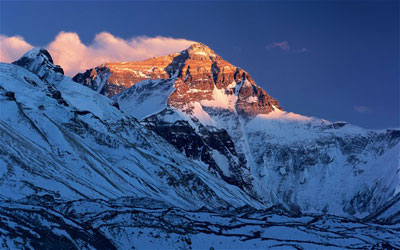
Mount Everest is the Earth's highest mountain, with a peak at 8,848 meters (29,029 ft) above sea level and the 5th tallest mountain measured from the center of the Earth. It is located in the Mahalangur section of the Himalayas. The international border between China and Nepal runs across the precise summit point. Its massif includes neighboring peaks Lhotse, 8,516 m (27,940 ft); Nuptse, 7,855 m (25,771 ft) and Changtse, 7,580 m (24,870 ft).
In 1856, the Great Trigonometric Survey of British India established the first published height of Everest, then known as Peak XV, at 29,002 ft (8,840 m). In 1865, Everest was given its official English name by the Royal Geographical Society upon a recommendation by Andrew Waugh, the British Surveyor General of India. Waugh named the mountain after his predecessor in the post, Sir George Everest. Although Tibetans had called Everest "Chomolungma" for centuries, Waugh was unaware of this because Nepal and Tibet were closed to foreigners.
Mount Everest attracts many highly experienced mountaineers as well as capable climbers willing to hire professional guides. While not posing substantial technical climbing challenges on the standard route, Everest presents dangers such as altitude sickness, weather and wind.
Discovery
In 1802, the British began the Great Trigonometric Survey of India to determine the location and names of the world's highest mountains. Starting in southern India, the survey teams moved northward using giant theodolites, each weighing 500 kg (1,100 lbs) and requiring 12 men to carry, to measure heights as accurately as possible. They reached the Himalayan foothills by the 1830s, but Nepal was unwilling to allow the British to enter the country because of suspicions of political aggression and possible annexation. Several requests by the surveyors to enter Nepal were turned down.
The British were forced to continue their observations from Terai, a region south of Nepal which is parallel to the Himalayas. Conditions in Terai were difficult because of torrential rains and malaria. Three survey officers died from malaria while two others had to retire due to failing health.
Nonetheless, in 1847, the British continued the Great Trigonometric survey and began detailed observations of the Himalayan peaks from observation stations up to 240 km (150 mi) away. Weather restricted work to the last three months of the year. In November 1847, Andrew Waugh, the British Surveyor General of India made several observations from the Sawajpore station located in the eastern end of the Himalayas. Kangchenjunga was then considered the highest peak in the world, and with interest he noted a peak beyond it, about 230 km (140 mi) away. John Armstrong, one of Waugh's officials, also saw the peak from a location farther west and called it peak "b". Waugh would later write that the observations indicated that peak "b" was higher than Kangchenjunga, but given the great distance of the observations, closer observations were required for verification. The following year, Waugh sent a survey official back to Terai to make closer observations of peak "b", but clouds thwarted all attempts.
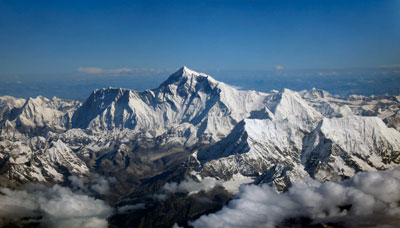
In 1849, Waugh dispatched James Nicolson to the area, who made two observations from Jirol, 190 km (120 mi) away. Nicolson then took the largest theodolite and headed east, obtaining over 30 observations from five different locations, with the closest being 174 km (108 mi) from the peak.
Nicolson retreated to Patna on the Ganges to perform the necessary calculations based on his observations. His raw data gave an average height of 9,200 m (30,200 ft) for peak "b", but this did not consider light refraction, which distorts heights. However, the number clearly indicated, that peak "b" was higher than Kangchenjunga. Then, Nicolson contracted malaria and was forced to return home without finishing his calculations. Michael Hennessy, one of Waugh's assistants, had begun designating peaks based on roman numerals, with Kangchenjunga named Peak IX, while peak "b" now became known as Peak XV.
In 1852, stationed at the survey headquarters in Dehradun, Radhanath Sikdar, an Indian mathematician and surveyor from Bengal, was the first to identify Everest as the world's highest peak, using trigonometric calculations based on Nicolson's measurements. An official announcement that Peak XV was the highest was delayed for several years as the calculations were repeatedly verified. Waugh began work on Nicolson's data in 1854, and along with his staff spent almost two years working on the calculations, having to deal with the problems of light refraction, barometric pressure, and temperature over the vast distances of the observations. Finally, in March 1856 he announced his findings in a letter to his deputy in Calcutta. Kangchenjunga was declared to be 28,156 ft (8,582 m), while Peak XV was given the height of 29,002 ft (8,840 m). Waugh concluded that Peak XV was "most probably the highest in the world". Peak XV (measured in feet) was calculated to be exactly 29,000 ft (8,839.2 m) high, but was publicly declared to be 29,002 ft (8,839.8 m) in order to avoid the impression that an exact height of 29,000 feet (8,839.2 m) was nothing more than a rounded estimate.
Measurement
The 8,848 m (29,029 ft) height given is officially recognized by Nepal and China, although Nepal is planning a new survey.
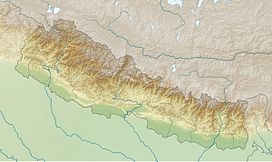
On 9 October 2005, after several months of measurement and calculation, the Chinese Academy of Sciences and State Bureau of Surveying and Mapping officially announced the height of Everest as 8,844.43 m (29,017.16 ft) with accuracy of plus/minus 0.21 m (0.69 ft). They claimed it was the most accurate and precise measurement to date. This height is based on the actual highest point of rock and not on the snow and ice covering it. The Chinese team also measured a snow/ice depth of 3.5 m (11 ft), which is in agreement with a net elevation of 8,848 m (29,029 ft). The snow and ice thickness varies over time, making a definitive height of the snow cap impossible to determine.
In 1856, Andrew Waugh announced Everest (then known as Peak XV) as 29,002 ft (8,840 m) high, after several years of calculations based on observations made by the Great Trigonometric Survey.
The elevation of 8,848 m (29,029 ft) was first determined by an Indian survey in 1955, made closer to the mountain, also using theodolites. It was subsequently reaffirmed by a 1975 Chinese measurement 8,848.13 m (29,029.30 ft). In both cases the snow cap, not the rock head, was measured. In May 1999 an American Everest Expedition, directed by Bradford Washburn, anchored a GPS unit into the highest bedrock. A rock head elevation of 8,850 m (29,035 ft), and a snow/ice elevation 1 m (3 ft) higher, were obtained via this device. Although it has not been officially recognized by Nepal, this figure is widely quoted. Geoid uncertainty casts doubt upon the accuracy claimed by both the 1999 and 2005 surveys.
A detailed photogrammetric map (at a scale of 1:50,000) of the Khumbu region, including the south side of Mount Everest, was made by Erwin Schneider as part of the 1955 International Himalayan Expedition, which also attempted Lhotse. An even more detailed topographic map of the Everest area was made in the late 1980s under the direction of Bradford Washburn, using extensive aerial photography.
It is thought that the plate tectonics of the area are adding to the height and moving the summit northeastwards. Two accounts suggest the rates of change are 4 mm (0.16 in) per year (upwards) and 3 to 6 mm (0.12 to 0.24 in) per year (northeastwards), but another account mentions more lateral movement (27 mm/1.1 in), and even shrinkage has been suggested.
Comparisons
The summit of Everest is the point at which the Earth's surface reaches the greatest distance above sea level. Several other mountains are sometimes claimed as alternative "tallest mountains on Earth". Mauna Kea in Hawaii is tallest when measured from its base; it rises over 10,200 m (6.3 mi) when measured from its base on the mid-ocean floor, but only attains 4,205 m (13,796 ft) above sea level.
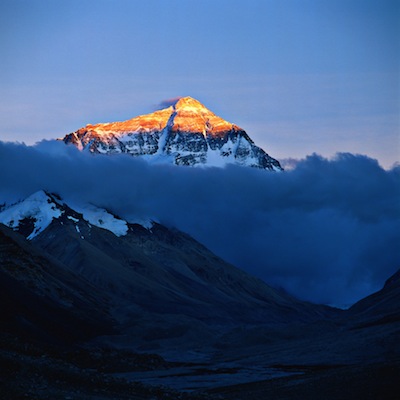
By the same measure of base to summit, Mount McKinley, in Alaska, is also taller than Everest. Despite its height above sea level of only 6,193.6 m (20,320 ft), Mount McKinley sits atop a sloping plain with elevations from 300 m (980 ft) to 900 m (3,000 ft), yielding a height above base in the range of 5,300 to 5,900 m (17,400 to 19,400 ft); a commonly quoted figure is 5,600 m (18,400 ft). By comparison, reasonable base elevations for Everest range from 4,200 m (13,800 ft) on the south side to 5,200 m (17,100 ft) on the Tibetan Plateau, yielding a height above base in the range of 3,650 to 4,650 m (11,980 to 15,260 ft).
The summit of Chimborazo in Ecuador is 2,168 m (7,113 ft) farther from the Earth's centre (6,384.4 km (3,967.1 mi)) than that of Everest (6,382.3 km (3,965.8 mi)), because the Earth bulges at the Equator. This is despite Chimborazo having a peak 6,268 m (20,564.3 ft) above sea level versus Mount Everest's 8,848 m (29,028.9 ft).
Climbing Routes
Mt. Everest has two main climbing routes, the southeast ridge from Nepal and the north ridge from Tibet, as well as many other less frequently climbed routes. Of the two main routes, the southeast ridge is technically easier and is the more frequently used route. It was the route used by Edmund Hillary and Tenzing Norgay in 1953 and the first recognized of fifteen routes to the top by 1996. This was, however, a route decision dictated more by politics than by design as the Chinese border was closed to the western world in the 1950s after the People's Republic of China invaded Tibet.
Most attempts are made during May before the summer monsoon season. As the monsoon season approaches, a change in the jet stream at this time pushes it northward, thereby reducing the average wind speeds high on the mountain. While attempts are sometimes made after the monsoons in September and October, when the jet stream is again temporarily pushed northward, the additional snow deposited by the monsoons and the less stable weather patterns (tail end of the monsoon) makes climbing extremely difficult.
Early Expeditions
In 1885, Clinton Thomas Dent, president of the Alpine Club, suggested that climbing Mount Everest was possible in his book Above the Snow Line.
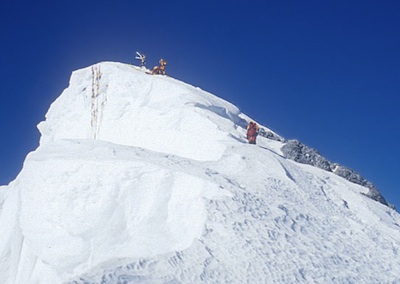
The northern approach to the mountain was discovered by George Mallory on the initial 1921 British Reconnaissance Expedition. It was an exploratory expedition not equipped for a serious attempt to climb the mountain. With Mallory leading (and thus becoming the first European to set foot on Everest's flanks) they climbed the North Col to an altitude of 7,005 m (22,982 ft). From there, Mallory espied a route to the top, but the party was unprepared for the great task of climbing any further and descended.
The British returned for a 1922 expedition. George Finch ("The other George") climbed using oxygen for the first time. He ascended at a remarkable speed—290 m (951 ft) per hour, and reached an altitude of 8,320 m (27,300 ft), the first time a human climbed higher than 8,000 m. This feat was entirely lost on the British climbing establishment—except for its "unsporting" nature. Mallory and Col. Felix Norton made a second unsuccessful attempt. Mallory was faulted for leading a group down from the North Col which got caught in an avalanche. Mallory was pulled down too, but seven native porters were killed.
The next Expedition was in 1924. The initial attempt by Mallory and Bruce was aborted when weather conditions precluded the establishment of Camp VI. The next attempt was that of Norton and Somervell, who climbed without oxygen and in perfect weather, traversing the North Face into the Great Couloir. Norton managed to reach 8,550 m (28,050 ft), though he ascended only 30 m (98 ft) or so in the last hour. Mallory rustled up oxygen equipment for a last-ditch effort. He chose young Andrew Irvine as his partner.
On 8 June 1924, George Mallory and Andrew Irvine made an attempt on the summit via the North Col/North Ridge/Northeast Ridge route from which they never returned. On 1 May 1999, the Mallory and Irvine Research Expedition found Mallory's body on the North Face in a snow basin below and to the west of the traditional site of Camp VI. Controversy has raged in the mountaineering community whether one or both of them reached the summit 29 years before the confirmed ascent (and of course, safe descent) of Everest by Sir Edmund Hillary and Tenzing Norgay in 1953.
In 1933, Lady Houston, a British millionairess, funded the Houston Everest Flight of 1933, which saw a formation of aircraft led by the Marquess of Clydesdale fly over the summit in an effort to deploy the British Union Flag at the top.
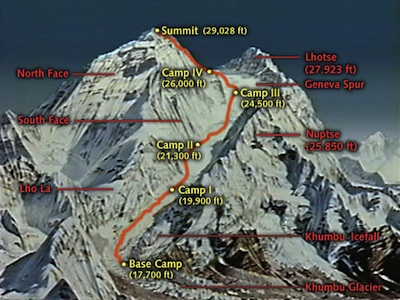
Early expeditions, such as Bruce's in the 1920s and Hugh Ruttledge's two unsuccessful attempts in 1933 and 1936, tried to make an ascent of the mountain from Tibet, via the north face. Access was closed from the north to western expeditions in 1950, after the Chinese asserted control over Tibet. In 1950, Bill Tilman and a small party which included Charles Houston, Oscar Houston and Betsy Cowles undertook an exploratory expedition to Everest through Nepal along the route which has now become the standard approach to Everest from the south.
The Swiss expedition of 1952, led by Edouard Wyss-Dunant, was granted permission to attempt a climb from Nepal. The expedition established a route through the Khumbu ice fall and ascended to the South Col at an elevation of 7,986 m (26,201 ft). No attempt at an ascent of Everest was ever under consideration in this case. Raymond Lambert and Sherpa Tenzing Norgay were able to reach a height of about 8,595 m (28,199 ft) on the southeast ridge, setting a new climbing altitude record. Tenzing's experience was useful when he was hired to be part of the British expedition in 1953.
First successful ascent by Tenzing and Hillary
In 1953, a ninth British expedition, led by John Hunt, returned to Nepal. Hunt selected two climbing pairs to attempt to reach the summit. The first pair (Tom Bourdillon and Charles Evans) came within 100 m (300 feet) of the summit on 26 May 1953, but turned back after running into oxygen problems. As planned, their work in route finding and breaking trail and their caches of extra oxygen were of great aid to the following pair. Two days later, the expedition made its second and final assault on the summit with its second climbing pair, the New Zealander Edmund Hillary and Tenzing Norgay, a Nepali sherpa climber from Darjeeling, India. They reached the summit at 11:30 am local time on 29 May 1953 via the South Col Route. At the time, both acknowledged it as a team effort by the whole expedition, but Tenzing revealed a few years later that Hillary had put his foot on the summit first. They paused at the summit to take photographs and buried a few sweets and a small cross in the snow before descending.
News of the expedition's success reached London on the morning of Queen Elizabeth II's coronation, 2 June. Returning to Kathmandu a few days later, Hunt (a Briton) and Hillary (a New Zealander) discovered that they had been promptly knighted in the Order of the British Empire, a KBE, for the ascent. Tenzing, a Nepali sherpa who was a citizen of India, was granted the George Medal by the UK. Hunt was ultimately made a life peer in Britain, while Hillary became a founding member of the Order of New Zealand. Hillary and Tenzing are also nationally recognized in Nepal, where annual ceremonies in schools and offices celebrate their accomplishment.
Statistics
By the end of the 2010 climbing season, there had been 5,104 ascents to the summit by about 3,142 individuals, with 77% of these ascents being accomplished since 2000. The summit was achieved in 7 of the 22 years from 1953 to 1974, and has not been missed since 1975. In 2007, the record number of 633 ascents was recorded, by 350 climbers and 253 sherpas.
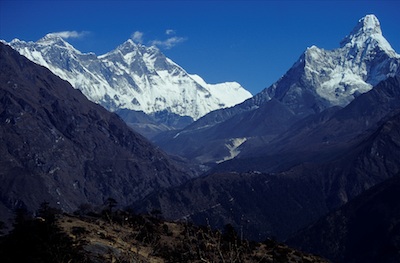
A remarkable illustration of the explosion of popularity of Everest is provided by the numbers of daily ascents. Analysis of the 1996 Mount Everest disaster shows that part of the blame was on the bottleneck caused by the large number of climbers (33 to 36) attempting to summit on the same day; this was considered unusually high at the time. By comparison, on 23 May 2010, the summit of Mount Everest was reached by 169 climbers - more summits in a single day than in the cumulative 31 years from the first successful summit in 1953 through 1983.
There have been 219 fatalities recorded on Mount Everest from the 1922 British Mount Everest Expedition through the end of 2010, a rate of 4.3 fatalities for every 100 summits (this is a general rate, and includes fatalities amongst support climbers, those who turned back before the peak, those who died en route to the peak and those who died while descending from the peak). Of the 219 fatalities, 58 (26.5%) were climbers who had summited but did not complete their descent. Though the rate of fatalities has decreased since the year 2000 (1.4 fatalities for every 100 summits, with 3938 summits since 2000), the significant increase in the total number of climbers still means 54 fatalities since 2000: 33 on the northeast ridge, 17 on the southeast ridge, 2 on southwest face, and 2 on north face.
Nearly all attempts at the summit are done using one of the two main routes. The traffic seen by each route varies from year to year. In 2005-07, more than half of all climbers elected to use the more challenging, but cheaper northeast route. In 2008, the northeast route was closed by the Chinese government for the entire climbing season, and the only people able to reach the summit from the north that year were athletes responsible for carrying the Olympic torch for the 2008 Summer Olympics. The route was closed to foreigners once again in 2009 in the run-up to the 50th anniversary of the Dalai Lama's exile. These closures led to declining interest in the north route, and, in 2010, two thirds of the climbers reached the summit from the south.
Death zone
At the higher regions of Mount Everest, climbers seeking the summit typically spend substantial time within the death zone (altitudes higher than 8,000 m (26,000 ft)), and face significant challenges to survival. Temperatures can dip to very low levels, resulting in frostbite of any body part exposed to the air. Since temperatures are so low, snow is well-frozen in certain areas and death or injury by slipping and falling can occur. High winds at these altitudes on Everest are also a potential threat to climbers.
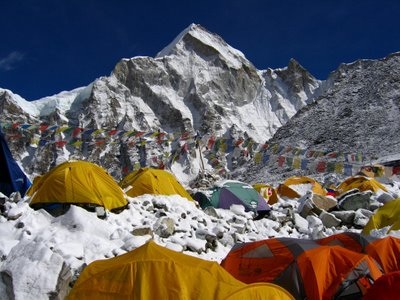
Another significant threat to climbers is low atmospheric pressure. The atmospheric pressure at the top of Everest is about a third of sea level pressure or 0.333 standard atmospheres (337 mbar), resulting in the availability of only about a third as much oxygen to breathe.
Debilitating effects of the death zone are so great that it takes most climbers up to 12 hours to walk the distance of 1.72 km (1.07 mi)) from South Col to the summit. Achieving even this level of performance requires prolonged altitude acclimatization, which takes 40-60 days for a typical expedition. A sea-level dweller exposed to the atmospheric conditions at the altitude above 28,000 feet (8,500 m) without acclimatization would likely lose consciousness within 2 to 3 minutes.
In May 2007, the Caudwell Xtreme Everest undertook a medical study of oxygen levels in human blood at extreme altitude. Over 200 volunteers climbed to Everest Base Camp where various medical tests were performed to examine blood oxygen levels. A small team also performed tests on the way to the summit.
Even at base camp, the low partial pressure of oxygen had direct effect on blood oxygen saturation levels. At sea level, blood oxygen saturation is generally 98% to 99%. At base camp, blood saturation fell to between 85% and 87%. Blood samples taken at the summit indicated very low oxygen levels in the blood. A side effect of low blood oxygen is a vastly increased breathing rate, often 80-90 breaths per minute as opposed to a more typical 20-30. Exhaustion can occur merely attempting to breathe.
Lack of oxygen, exhaustion, extreme cold, and climbing hazards all contribute to the death toll. An injured person who cannot walk is in serious trouble, since rescue by helicopter is generally impractical and carrying the person off the mountain is very risky. People who die during the climb are typically left behind. About 150 bodies have never been recovered. It is not uncommon to find corpses near the standard climbing routes.
Supplemental Oxygen
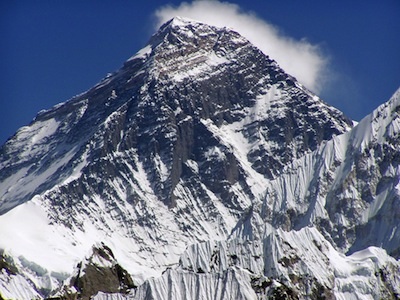
Most expeditions use oxygen masks and tanks above 8,000 m (26,000 ft). Everest can be climbed without supplementary oxygen, but only by the most accomplished mountaineers and at increased risk. Humans do not think clearly with low oxygen, and the combination of extreme weather, low temperatures, and steep slopes often require quick, accurate decisions.
The use of bottled oxygen to ascend Mount Everest has been controversial. It was first used on the 1922 British Mount Everest Expedition by George Finch and Geoffrey Bruce who climbed up to 7,800 m (25,600 ft) at a spectacular speed of 1000 vertical feet per hour (vf/h). Pinned down by a fierce storm, they escaped death by breathing oxygen from a jury-rigged set-up during the night. The next day they climbed to 8,100 m (26,600 ft) at 900 vf/h-nearly three times as fast as non-oxygen users. Yet the use of oxygen was considered so unsportsmanlike that none of the rest of the Alpine world recognized this high ascent rate. George Mallory himself described the use of such oxygen as unsportsmanlike, but he later concluded that it would be impossible for him to summit without it and consequently used it on his final attempt in 1924. When Tenzing and Hillary made the first successful summit in 1953, they used bottled oxygen. For the next twenty-five years, bottled oxygen was considered standard for any successful summit.
Reinhold Messner was the first climber to break te bottled oxygen tradition and in 1978, with Peter Habeler, made the first successful climb without it. Although critics alleged that he sucked mini-bottles of oxygen-a claim that Messner denied-Messner silenced them when he summited the mountain solo, without supplemental oxygen or any porters or climbing partners, on the more difficult northwest route, in 1980. Once the climbing community was satisfied that the mountain could be climbed without supplemental oxygen, many purists then took the next logical step of insisting that's how it should be climbed.
The aftermath of the 1996 disaster further intensified the debate. Jon Krakauer's Into Thin Air (1997) expressed the author's personal criticisms of the use of bottled oxygen. Krakauer wrote that the use of bottled oxygen allowed otherwise unqualified climbers to attempt to summit, leading to dangerous situations and more deaths. The 10-11 May 1996 disaster was partially caused by the sheer number of climbers (34 on that day) attempting to ascend, causing bottlenecks at the Hillary Step and delaying many climbers, most of whom summitted after the usual 2 p.m. turnaround time. He proposed banning bottled oxygen except for emergency cases, arguing that this would both decrease the growing pollution on Everest-many bottles have accumulated on its slopes—and keep marginally qualified climbers off the mountain.
The 1996 disaster also introduced the issue of the guide's role in using bottled oxygen. Guide Anatoli Boukreev's decision not to use bottled oxygen was sharply criticized by Jon Krakauer. Boukreev's supporters (who include G. Weston DeWalt, who co-wrote The Climb) state that using bottled oxygen gives a false sense of security. Krakauer and his supporters point out that, without bottled oxygen, Boukreev could not directly help his clients descend. They state that Boukreev said that he was going down with client Martin Adams, but just below the South Summit, Boukreev determined that Adams was doing fine on the descent and so descended at a faster pace, leaving Adams behind. Adams states in The Climb: "For me, it was business as usual, Anatoli's going by, and I had no problems with that."
